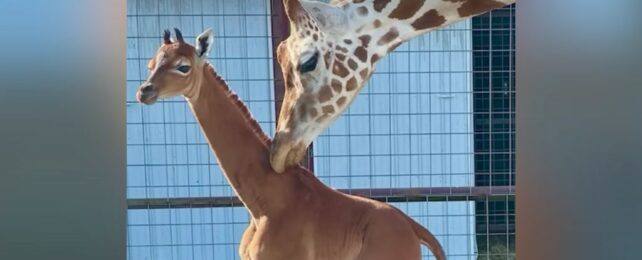A giraffe born without spots sounds like the plot of a children's book – and actually is one – but this quirky coming-of-age story is also unfolding right now in real life.
On the 31st of July, Brights Zoo in Tennessee welcomed a new baby giraffe without any spots to the world. Her coat is a solid brown color.
The giraffe is possibly one of a kind. While scientists acknowledge that her species, reticulated giraffes (Giraffa reticulata), are born without spots on very rare occasions, there is no other known example living anywhere on Earth according to officials at Brights Zoo.
"From day one we've been in contact with zoo professionals all over the country," the director of the zoo, David Bright, told the Tennessee television news station, WJHL.
"And especially the old timers, that have been around for a long time, 'Hey, have you seen this? What's your thoughts?' And nobody's seen it."
At least – not in recent years. Apparently there are historical reports of a spotless giraffe born in captivity in Japan in the 1970s, but no pictures have yet surfaced online.
The distinctive blotches of dark fur found on reticulated giraffes are not random in pattern or shape, but are inherited from their mother.
The distinctive patterns are thought to provide camouflage, suggesting individuals born without them might struggle to hide from predators in the wild.
In one study, calves with larger and more irregularly shaped spots were found to have a better chance at survival a few months into life; although this was just a correlation, and the spots could also play a role in visual communication or temperature control.
Given the risks, it's possible that the spotless giraffe in Tennessee is better off in captivity. Just a few weeks after her birth, she already stands six feet tall.
Officials at the zoo are now asking the public to help choose her name.
They've carefully selected four potential Swahili words as candidates: Kipekee, which means "unique", Firayali, which means "unusual", Shakiri, which means "she is most beautiful", and Jamella, which means "one of great beauty".
Bright told WJHL that he hopes the recent media coverage on this spotless giraffe will put a "much-needed spotlight on giraffe conservation" as a whole.
For decades now, giraffes have been heading towards a 'silent extinction', mostly due to unfettered habitat losses, civil unrest, and poaching. Over the past 30 years, Africa's population has plummeted 40 percent, leaving only 16,000 reticulated giraffes left.
Ironically enough, the world's tallest mammals have a history of being overlooked. Before 2016, researchers didn't even realize they were split into four species, and in recent years, we've started learning all these cool facts about them, from their weird, urine-sniffing sex lives to the great feats of their small brains.
It's not just this one female born in Tennessee that's unique, it's her whole unusual genus.
